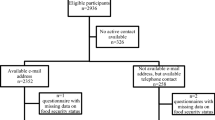Abstract
Objectives of this study: (1) Examine food insecurity (FI) prevalence and its relationship with sociodemographic and pre-resettlement characteristics; (2) Investigate differences in amount of money spent on food/month by food security status and socio-demographic characteristics. A pilot study with semi-structured in-home interviews was conducted with Liberian caregivers (n = 33). FI was indicated in 61 % of households. FI was higher among women >40, had ≤ high school education and those making ≤$1,000/month. Women arriving in US >15 years of age were more likely to be food insecure. Participants spent an average $109/month on groceries/member. Food insecure women, and those without a car spent more money on food (P < .10). Liberian women in this sample experience high levels of FI upon resettlement. Besides poor economic conditions, pre-resettlement characteristics were associated with food security status. These findings call for future research to understand how preresettlement conditions affect food choices, budgeting and thereby food security status.
Similar content being viewed by others
Notes
The SNAP, formerly identified as the Food Stamp Program, provides food-purchasing assistance to low-income individuals living in the US.
The Special Supplemental Nutrition Program for WIC is a US federal grant-funded program that provides supplemental foods, health care referrals, and nutrition education for low-income pregnant, breastfeeding, and non-breastfeeding postpartum women. This funding also provides for infants and children up to age five (found to be at nutritional risk).
References
Alaimo K, Olson CM, Frongillo EA. Low family income and food insufficiency in relation to overweight in US children: is there a paradox? Arch Pediatr Adolesc Med. 2001;155:1161–7.
Alaimo K, Olson CM, Frongillo EA. Family food insufficiency, but not low family income, is positively associated with dysthymia and suicide symptoms in adolescents. J Nutr. 2002;132:719–25.
Cook JT, Frank DA, Berkowitz C, et al. Food insecurity is associated with adverse health outcomes among human infants and toddlers. J Nutr. 2004;134:1432–8.
Himmelgreen D, Pe′rez-Escamilla R, Segura-Milla′n P, et al. Food insecurity among low-income Hispanics in Hartford, Connecticut: implications for public health policy. Hum Organ. 2000;59:334–42.
Townsend MS, Peerson J, Love B, et al. Food insecurity is positively related to overweight in women. J Nutr. 2001;131:1738–45.
Larson NI, Story MT. Food insecurity and weight status among U.S. children and families: a review of the literature. Am J Prev Med. 2011;40:166–73.
Holben DH, American Dietetic Association. Position of the American Dietetic Association: food insecurity in the United States. J Am Diet Assoc. 2010;110:1368–77.
Coleman-Jensen A, Nord M, Andrews M, Carlson S. Household food security in the United States in 2010. United States Department of Agriculture Economic Research Service Report Number; 2011: 125.
Chilton M, Black M, Berkowitz C, et al. Food insecurity and risk of poor health among US-born children of immigrants. Am J Public Health. 2009;99:556–62.
Hadley C, Zodhiates A, Sellen DW. Acculturation, economics and food insecurity among refugees resettled in the USA: a case study of West African refugees. Public Health Nutr. 2007;10:405–12.
Dharod J, Croom J, Sady C, Morrell D. Relationships between dietary intake, food security and acculturation among Somali refugees in the U.S.: results of a pilot study. J Immigr Refug Stud. 2011;9:82–97.
Dharod J, Croom J, Sady C. Food insecurity: its relationship to dietary intake and body weight among Somali refugee women in the U.S. J Nutr Educ Behav. 2013;45:47–53.
Piwowarczyk L, Keane TM, Lincoln A. Hunger: the silent epidemic among asylum seekers and resettled refugees. Int Migr. 2008;46:59–77.
Peterman JN, Wilde PE, Liang S, et al. Relationship between past food deprivation and current dietary practices and weight status among Cambodian refugee women in Lowell, MA. Am J Public Health. 2010;100:1930–7.
Hadley C, Patil C, Nahayo D. Difficulty in the food environment and the experience of food insecurity among refugees resettled in the United States. Ecol Food Nutr. 2010;49:390–407.
Kiptinness C, Dharod J. Bhutanese refugees in the US: their dietary habits and food shopping practices upon resettlement. J Hunger Environ Nutr. 2011;6:75–85.
Patil CL, Hadley C, Nahayo PD. Unpacking dietary acculturation among new Americans: results from formative research with African refugees. J Immigr Minor Health. 2009;11:342–58.
Decker J. Eating habits of members of the Somali community: discussion summary. United States Department of Agriculture—Nutrition Education website. http://snap.nal.usda.gov/foodstamp/resource_finder_details.php?id=323.
Burns C. Effect of migration on food habits of Somali women living as refugees in Australia. Ecol Food Nutr. 2004;43:213–29.
Marcos-Dunn R, Kollehlon KT, Ngovo B, et al. Liberians: an introduction to their history and culture. Center for Applied Linguistics. Culture Profile No. 19; 2005.
United Nations High Commissioner for Refugees: The UN Refugee Agency. Global trends: Refugees, Asylum-seekers, Returnees, Internally displaced and Stateless persons. Geneva; 2010.
Rytina NF. U.S. Department of Homeland Security. Office of Immigration Statistics. Refugee applicants and admissions to the United States; 2005.
Martin D, Hoefer M. Annual flow report—refugees and asylees: 2008 US Dept. of Homeland Security, DHS Office of Immigration Statistics; 2009.
Economic Research Service. ERS/USDA briefing room—food security in the United States, briefing published by the US Department of Agriculture; 2011. www.ers.usda.gov/Briefing/FoodSecurity/howoften.htm.
Hadley C, Sellen D. Food insecurity and child hunger among recently resettled liberian refugees and asylum seekers: a pilot study. J Immigr Minor Health. 2006;8(4):369–75.
Post Arrival Assistance and Benefits. Retrieved 2011, from Refugee Council USA. http://www.rcusa.org/index.php?page=post-arrival-assistance-and-benefits.
Author information
Authors and Affiliations
Corresponding author
Rights and permissions
About this article
Cite this article
Nunnery, D.L., Haldeman, L.A., Morrison, S.D. et al. Food Insecurity and Budgeting Among Liberians in the US: How are They Related to Socio-demographic and Pre-resettlement Characteristics. J Immigrant Minority Health 17, 506–512 (2015). https://doi.org/10.1007/s10903-014-9993-y
Published:
Issue Date:
DOI: https://doi.org/10.1007/s10903-014-9993-y




